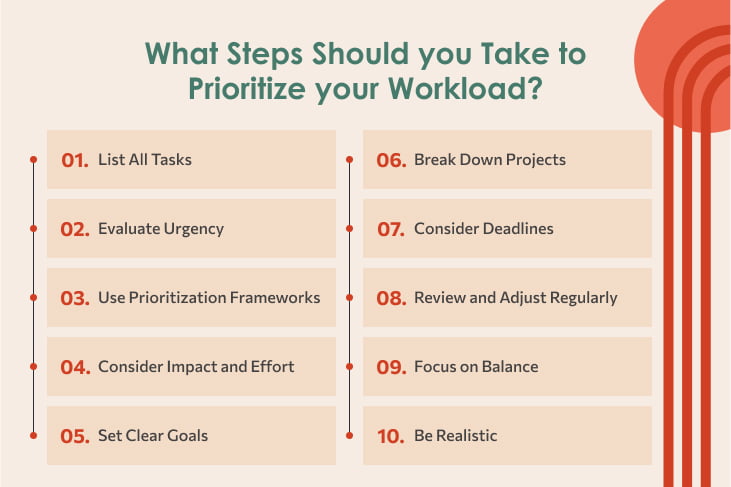Task prioritizing is a critical skill for success, regardless of whether you’re a professional looking to maximize productivity or a student juggling a busy schedule. In order to help you efficiently prioritize your work and make sure that your energy is directed where it counts most, this blog examines practical solutions. Together, we will explore how to effectively prioritize tasks and confidently tackle them.
What steps should you take to prioritize your workload?

To successfully prioritize your workload and allocate your time and attention to the most important activities, there are many essential processes involved:
- List All Tasks: Start by making a comprehensive list of all the tasks you need to accomplish.
- Evaluate Urgency: Assess each task based on its importance and urgency.
- Use Prioritization Frameworks: To classify tasks according to their urgency and significance, take into consideration utilizing prioritization frameworks like the ABCDE technique. These frameworks assist you in determining which tasks are less important, which may be assigned to others or postponed, and which are crucial.
- Consider Impact and Effort: Evaluate the potential impact of each task on your overall goals or objectives. Additionally, consider the effort required to complete each task.
- Set Clear Goals: Identify the most critical goals you need to achieve, and prioritize tasks that contribute directly to those goals.
- Break Down Projects: Divide highly complex projects or activities into smaller, easier-to-manage subtasks. This enables you to move the project forward gradually and give priority to certain tasks.
- Consider Deadlines: Take note of any deadlines associated with your tasks. Tasks with imminent deadlines may need to be prioritized higher than those with flexible timelines.
- Review and Adjust Regularly: Regularly review your task list and adjust priorities as needed. Circumstances may change, new tasks may arise, and priorities may shift over time. Stay flexible and responsive to changes in your workload.
- Focus on Balance: Strive for a balance between short-term and long-term priorities, as well as between work and personal commitments. Avoid overloading yourself with too many urgent tasks at the expense of important but less pressing responsibilities.
- Be Realistic: Finally, be realistic about what you can accomplish within a given timeframe. Prioritize tasks based on your available resources, time constraints, and energy levels.
What is the best way to prioritize tasks?
The best way to prioritize tasks is by using a project management tool like Alian Hub. Using the tool’s capabilities and functionalities, you can organize tasks according to their urgency and relevance.
- Make a list of everything that has to be done for your project in the beginning. If required, divide more complex tasks into sprints. Enter the task name into the project management software, Alian Hub.
- Assign due dates to each work according to its significance, dependencies, and the project’s overall schedule. Set reasonable deadlines on Alian Hub to make sure that work is finished on time.
- Alian Hub has alternatives like high, medium, and low priorities. Assign each task a corresponding priority.
- To search for prioritized tasks according to their urgency and significance use the filtering feature of Alian Hub.
- Furthermore, Alian Hub allows you to use labels or tags to categorize tasks based on different criteria, such as project phase, team member responsible, or type of task. Utilize these labels to further prioritize and organize tasks.
- As the project moves forward, evaluate and update to prioritize tasks on a regular basis. Reprioritization may be required due to variables like new knowledge, needs, or deadlines that change. Monitor task priorities often to make sure they are in line with project objectives.
- Ensure that all team members are aware of task priorities and understand their role in achieving them.
Conclusion
Prioritize tasks to increase productivity and succeed in your personal and professional efforts. You may efficiently manage their workload by employing a methodical strategy that includes making a list of activities, assessing urgency, using prioritizing frameworks, taking impact and effort into account, establishing clear goals, and routinely reviewing priorities.
The prioritizing process may also be streamlined by using project management solutions like Alian Hub, which provide capabilities like priority assignment, task classification, and deadline management. In the end, businesses may maximize their time and energy to concentrate on what matters most by setting strategic priorities.
Frequently asked questions
How do I know which tasks are the most important?
Prioritize tasks based on their urgency, impact on goals, and effort required. Utilize prioritization frameworks like the ABCDE technique to categorize tasks according to their significance.
What if I have too many tasks to prioritize?
Break down complex projects into smaller, more manageable tasks. Focus on balancing short-term and long-term priorities, and be realistic about what you can accomplish within your available resources and time constraints.
How often should I review and adjust task priorities?
Regularly review your task list and adjust priorities as needed. Circumstances may change, new tasks may arise, and priorities may shift over time. Stay flexible and responsive to changes in your workload.
How can project management tools help with task prioritization?
Project management tools like Alian Hub offer features such as task categorization, deadline management, priority assignment, and task filtering. These tools streamline the prioritization process and help individuals stay organized and focused on achieving project objectives.
How can I ensure that my team is aligned with task priorities?
Communicate task priorities clearly with your team and ensure that everyone understands their role in achieving them. Regularly update team members on changes to task priorities and encourage collaboration in the prioritization process.

